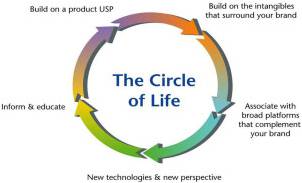For any brand to be King, you have to begin by understanding the Communication Life Cycle of the product category in which the brand operates. And here is a simple illustration of that life cycle.
When a new product category is born, inspired by some new technology or lifestyle changes that bring about a new perspective, the first phase in the Communication Life Cycle is based on the need to ‘Inform and Educate’.
Let’s take Cellular as an example. When technology brought cell phones into our lives, there was a need to tell us how to use it, where to use it, even when to use it, costs and so on. The early players did just that.
As more players jumped onto the cellular bandwagon, brands pressed by the need to differentiate moved into Phase Two of the Communication Life Cycle. Communication built on a Unique Selling Proposition, one that helped build a slot in the mind of the consumer. So the days of widest network, clearest signal, simplest plans, etc arrived.
When USP slots were quickly filled, brands moved into Phase Three, surrounding themselves with symbols, images, sounds and feelings that reflected the core values of the brand and set them apart in the minds of the customer.
Brands like Hutch/Vodafone did this superbly by being consistent and starting this process from Phase One itself. This has stood them in good stead. But man others, who were unable to still own a spot in the mind of the customer quickly moved on to Phase Four — and here they ran into a wall.
Unlike an MRF who, over the years, have come to own motor racing and pace bowling (both associated with pace and performance and hence relevant and meaningful for the brand), most brands looking for a quick fix platform to hitch a ride upon found themselves floundering.
Airtel has had limited success with ‘Music’ as a platform. Aircel, more recently, did not cut any ice with its ‘Save the Tiger’ platform.Realizing that relevant & meaningful platforms are hard to find and even harder to own, most brands have been using the quick fix solution of ‘Hitching upon a Star’ to see them through Phase Four. Hence the plethora of Brand Ambassadors who are the bane of Indian Advertising today. Unfortunately, in the frantic haste to snuggle up to the customer, brands are not being very picky about the Stars they choose, often going by who is available and at what price, rather than who
represents the core values of the brand in a relevant & meaningful way.
As Phase Four of the category Communication Life Cycle slowly winds down, new technology (smart phones) or a new perspective (“I can make a difference”- crowd sourcing) kicks in and the circle of life rolls over again.
For a brand that hopes to be King, there are some obvious lessons here from a communication perspective: It pays to start building the brand in a consistent and relevant way from day one.
Phases one to three are the more transient phases. A brand spends its most productive life in Phase Four, gathering strength to pass onto the next circle of life.
The urge to jump straight to Phase Four can be a strong one, but unless the foundation is strong and the brand has been through the trials and tribulations and the rigour of phases one to three, Phase Four can become a time of deep uncertainty rather than a period of strength and stability.
Understanding and plotting where the product category is on the Communication Life Cycle can help fine tune the brand’s appeal to its customers. So Hutch, when launched, understood that the category was past the ‘Inform and Educate’ phase and came in with the simple ‘Hi’ campaign that helped the brand immediately connect with its customers and set the tone for all the communication to come. They then captured the hearts and minds of cellular users with the Pug campaign, helping them own ’widest network’ and become King in Phase Two of the Communication Life Cycle. Today, they are probably the only large brand in the country that has never used a STAR as a brand ambassador, choosing, instead, to build on the platform of simplicity that they owned from the day they launched with just one word: “Hi”.
To quote T.S. Elliot – “We shall not cease from exploration, and the end of all our exploring will be, to arrive where we started and know the place for the first time.”
(R. Krishnamohan)
Let’s take Cellular as an example. When technology brought cell phones into our lives, there was a need to tell us how to use it, where to use it, even when to use it, costs and so on. The early players did just that.
As more players jumped onto the cellular bandwagon, brands pressed by the need to differentiate moved into Phase Two of the Communication Life Cycle. Communication built on a Unique Selling Proposition, one that helped build a slot in the mind of the consumer. So the days of widest network, clearest signal, simplest plans, etc arrived.
When USP slots were quickly filled, brands moved into Phase Three, surrounding themselves with symbols, images, sounds and feelings that reflected the core values of the brand and set them apart in the minds of the customer.
Brands like Hutch/Vodafone did this superbly by being consistent and starting this process from Phase One itself. This has stood them in good stead. But man others, who were unable to still own a spot in the mind of the customer quickly moved on to Phase Four — and here they ran into a wall.
Unlike an MRF who, over the years, have come to own motor racing and pace bowling (both associated with pace and performance and hence relevant and meaningful for the brand), most brands looking for a quick fix platform to hitch a ride upon found themselves floundering.
Airtel has had limited success with ‘Music’ as a platform. Aircel, more recently, did not cut any ice with its ‘Save the Tiger’ platform.Realizing that relevant & meaningful platforms are hard to find and even harder to own, most brands have been using the quick fix solution of ‘Hitching upon a Star’ to see them through Phase Four. Hence the plethora of Brand Ambassadors who are the bane of Indian Advertising today. Unfortunately, in the frantic haste to snuggle up to the customer, brands are not being very picky about the Stars they choose, often going by who is available and at what price, rather than who
represents the core values of the brand in a relevant & meaningful way.
As Phase Four of the category Communication Life Cycle slowly winds down, new technology (smart phones) or a new perspective (“I can make a difference”- crowd sourcing) kicks in and the circle of life rolls over again.
For a brand that hopes to be King, there are some obvious lessons here from a communication perspective: It pays to start building the brand in a consistent and relevant way from day one.
Phases one to three are the more transient phases. A brand spends its most productive life in Phase Four, gathering strength to pass onto the next circle of life.
The urge to jump straight to Phase Four can be a strong one, but unless the foundation is strong and the brand has been through the trials and tribulations and the rigour of phases one to three, Phase Four can become a time of deep uncertainty rather than a period of strength and stability.
Understanding and plotting where the product category is on the Communication Life Cycle can help fine tune the brand’s appeal to its customers. So Hutch, when launched, understood that the category was past the ‘Inform and Educate’ phase and came in with the simple ‘Hi’ campaign that helped the brand immediately connect with its customers and set the tone for all the communication to come. They then captured the hearts and minds of cellular users with the Pug campaign, helping them own ’widest network’ and become King in Phase Two of the Communication Life Cycle. Today, they are probably the only large brand in the country that has never used a STAR as a brand ambassador, choosing, instead, to build on the platform of simplicity that they owned from the day they launched with just one word: “Hi”.
To quote T.S. Elliot – “We shall not cease from exploration, and the end of all our exploring will be, to arrive where we started and know the place for the first time.”
(R. Krishnamohan)


